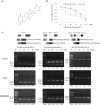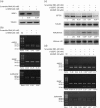4β-Hydroxywithanolide E Modulates Alternative Splicing of Apoptotic Genes in Human Hepatocellular Carcinoma Huh-7 Cells
- PMID: 28779122
- PMCID: PMC5544667
- DOI: 10.1038/s41598-017-07472-6
4β-Hydroxywithanolide E Modulates Alternative Splicing of Apoptotic Genes in Human Hepatocellular Carcinoma Huh-7 Cells
Abstract
Alternative splicing is a mechanism for increasing protein diversity from a limited number of genes. Studies have demonstrated that aberrant regulation in the alternative splicing of apoptotic gene transcripts may contribute to the development of cancer. In this study, we isolated 4β-Hydroxywithanolide E (4bHWE) from the traditional herb Physalis peruviana and investigated its biological effect in cancer cells. The results demonstrated that 4bHWE modulates the alternative splicing of various apoptotic genes, including HIPK3, SMAC/DIABLO, and SURVIVIN. We also discovered that the levels of SRSF1 phospho-isoform were decreased and the levels of H3K36me3 were increased in 4bHWE treatment. Knockdown experiments revealed that the splicing site selection of SMAC/DIABLO could be mediated by changes in the level of H3K36me3 in 4bHWE-treated cells. Furthermore, we extended our study to apoptosis-associated molecules, and detected increased levels of poly ADP-ribose polymerase cleavage and the active form of CASPASE-3 in 4bHWE-induced apoptosis. In vivo experiments indicated that the treatment of tumor-bearing mice with 4bHWE resulted in a marked decrease in tumor size. This study is the first to demonstrate that 4bHWE affects alternative splicing by modulating splicing factors and histone modifications, and provides a novel view of the antitumor mechanism of 4bHWE.
Conflict of interest statement
The authors declare that they have no competing interests.
Figures








Similar articles
-
Alternative splicing in human cancer cells is modulated by the amiloride derivative 3,5-diamino-6-chloro-N-(N-(2,6-dichlorobenzoyl)carbamimidoyl)pyrazine-2-carboxide.Mol Oncol. 2019 Aug;13(8):1744-1762. doi: 10.1002/1878-0261.12524. Epub 2019 Jun 1. Mol Oncol. 2019. PMID: 31152681 Free PMC article.
-
The Roles of 4β-Hydroxywithanolide E from Physalis peruviana on the Nrf2-Anti-Oxidant System and the Cell Cycle in Breast Cancer Cells.Am J Chin Med. 2016;44(3):617-36. doi: 10.1142/S0192415X16500348. Epub 2016 Apr 24. Am J Chin Med. 2016. PMID: 27109152
-
The apoptosis inducing effect of Glycosmis pentaphylla (Retz.) Correa and its influence on gene expression in hepatocellular carcinoma cell line, Hep3 B.J Ethnopharmacol. 2012 Jan 31;139(2):359-65. doi: 10.1016/j.jep.2011.11.012. Epub 2011 Nov 26. J Ethnopharmacol. 2012. PMID: 22138516
-
Expression of IAPs and alternative splice variants in hepatocellular carcinoma tissues and cells.Ann N Y Acad Sci. 2004 Dec;1028:289-93. doi: 10.1196/annals.1322.033. Ann N Y Acad Sci. 2004. PMID: 15650254 Review.
-
Alternative Splicing in Hepatocellular Carcinoma.Cell Mol Gastroenterol Hepatol. 2020;10(4):699-712. doi: 10.1016/j.jcmgh.2020.04.018. Epub 2020 May 8. Cell Mol Gastroenterol Hepatol. 2020. PMID: 32389640 Free PMC article. Review.
Cited by
-
Construction of prognostic predictor by comprehensive analyzing alternative splicing events for colon adenocarcinoma.World J Surg Oncol. 2020 Sep 3;18(1):236. doi: 10.1186/s12957-020-02010-7. World J Surg Oncol. 2020. PMID: 32883335 Free PMC article.
-
Epigenetic Regulation and Therapeutic Targeting of Alternative Splicing Dysregulation in Cancer.Pharmaceuticals (Basel). 2025 May 12;18(5):713. doi: 10.3390/ph18050713. Pharmaceuticals (Basel). 2025. PMID: 40430531 Free PMC article. Review.
-
Alternative splicing in human cancer cells is modulated by the amiloride derivative 3,5-diamino-6-chloro-N-(N-(2,6-dichlorobenzoyl)carbamimidoyl)pyrazine-2-carboxide.Mol Oncol. 2019 Aug;13(8):1744-1762. doi: 10.1002/1878-0261.12524. Epub 2019 Jun 1. Mol Oncol. 2019. PMID: 31152681 Free PMC article.
-
Golden berry 4β-hydroxywithanolide E prevents tumor necrosis factor α-induced procoagulant activity with enhanced cytotoxicity against human lung cancer cells.Sci Rep. 2021 Feb 25;11(1):4610. doi: 10.1038/s41598-021-84207-8. Sci Rep. 2021. PMID: 33633307 Free PMC article.
-
Alternative Splicing as a Target for Cancer Treatment.Int J Mol Sci. 2018 Feb 11;19(2):545. doi: 10.3390/ijms19020545. Int J Mol Sci. 2018. PMID: 29439487 Free PMC article. Review.
References
Publication types
MeSH terms
Substances
LinkOut - more resources
Full Text Sources
Other Literature Sources
Medical
Molecular Biology Databases
Research Materials

